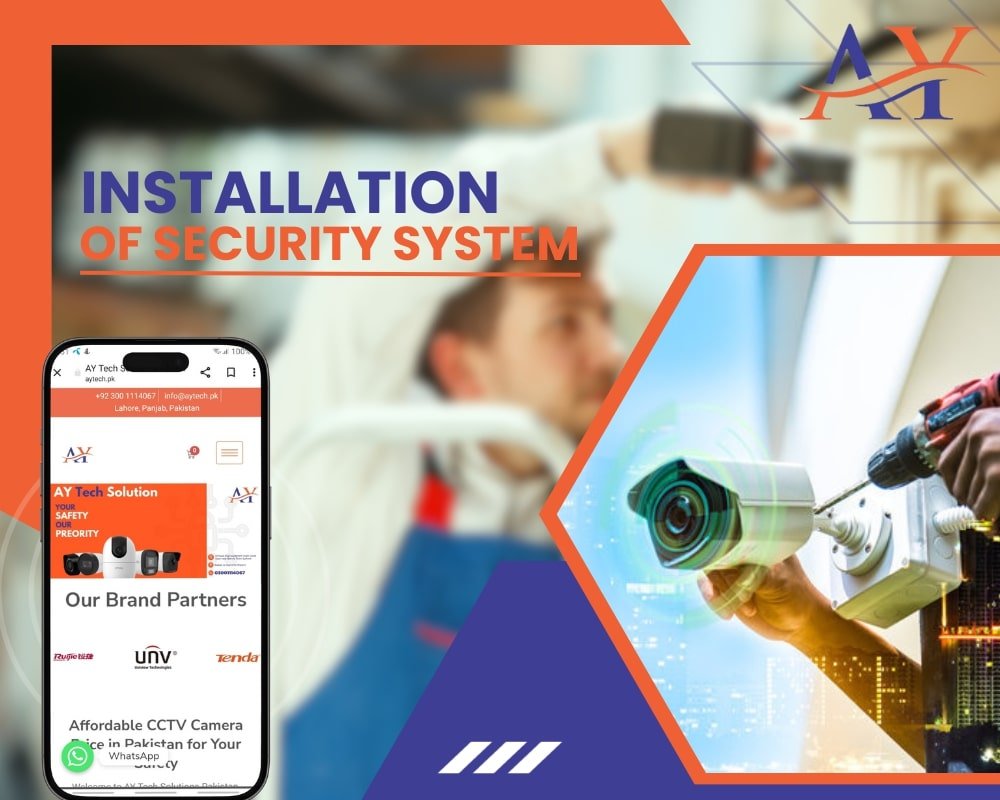Uncategorised
Installation of CCTV cameras In Pakistan step by step guide
Installation of CCTV cameras In Pakistan
Welcome to Ay Tech Solution. We are providing step-by-step guidance for the installation of CCTV cameras, in Pakistan. Installing CCTV cameras can greatly enhance the security of your home or business, providing a watchful eye even when you’re not physically present. This step-by-step guide aims to simplify the process, making it accessible for individuals with varying levels of technical expertise.
- Assessment and Planning: Before diving into installation, assess the areas you want to monitor. Identify key entry points and vulnerable areas. Plan camera placements strategically to ensure comprehensive coverage.
- Choose the Right Cameras: Select cameras based on your specific needs. Consider factors like resolution, night vision capabilities, and weather resistance. Make sure the cameras are suitable for both indoor and outdoor use if needed.
- Gather Necessary Tools and Equipment: Collect tools such as a drill, screwdriver, and cable connectors. Ensure you have all the cables, power adapters, and any additional accessories required for your connector camera system. Install the Cameras: Mount strategically at the chosen locations. Adjust angles to optimize the field of view. Use the appropriate tools to fix the cameras firmly in place.
- Run Cables: Carefully run cables from the cameras to the central recording unit. Conceal cables where possible to deter tampering and maintain a neat appearance. Connect Cameras to the
- Recording Unit: Follow the manufacturer’s instructions to connect the cameras to the recording Unit. This may involve attaching cables and configuring settings for optimal performance.
- Power Up the System: Connect the recording unit to power and turn it on. Ensure all cameras receive power as well. Check for proper functionality and adjust settings if necessary.
- Set Up Monitoring Devices: Install and configure any devices you’ll use to monitor the CCTV feed, such as a computer, smartphone, or dedicated monitor. Download any required apps or software.
- Test the Them : Perform thorough testing to confirm that all cameras are functioning correctly. Check for clear video quality, proper night vision, and accurate motion detection.
Site and Assessment For CCTV Cameras Installation:
Selecting an ideal site for CCTV camera installation involves careful assessment to ensure effective surveillance. Begin by identifying key areas that require monitoring, such as entrances, parking lots, and high-traffic zones. Consider the layout of the site and potential blind spots that may compromise security. Conduct a thorough risk assessment to determine potential security threats and vulnerabilities. This includes evaluating the likelihood of theft, trashing, or unauthorized access.
- Power supply source availability: Take into account existing lighting conditions, as proper illumination enhances camera effectiveness. Additionally, assess power sources for camera placement and ensure connectivity to a reliable power supply. Evaluate the need for additional equipment, such as infrared cameras for low-light situations.
- Optimal Height for CCTV Cameras installation :Strategically position cameras at optimal heights and angles to camera Installation avoid obstructions and ensure the field of view covers critical areas. Consider weather conditions and select cameras with suitable protection exposed to the elements.
- Regular maintenance: Regular maintenance is crucial for sustained performance. Establish a schedule for cleaning, testing, and updating software to maximize CCTV, Functionality . Be carefully considering these factors, you can create a comprehensive plan for CCTV installed in specific areas and provide peace of mind.
Types of CCTV cameras for Installation:
There are different kinds of CCTV cameras, For Installation in Pakistan. Types of CCTV Cameras below given below .
- Dome Cameras. These are round CCTV Cameras, often functionality blend into their surroundings.
- Bullet Cameras: Sleek, cylindrical cameras suitable for both indoor and functionality.
- PTZ Cameras (Pan-Tilt-Zoom): Flexible cameras that can be remotely controlled to pan, tilt, and zoom.
- IP Cameras: Internet Protocol cameras for transmitting data over networks, offering high- resolution images.
- “Wireless Cameras”: Eliminate the need for cables, relying on Wi-Fi connections for data transmission.
- Infrared/Night Vision Cameras: Equipped with infrared LEDs to capture clear images in low-light or no-light conditions.
- Covert/Hidden Cameras: Disguised as everyday objects, there resolution are used for discrete surveillance.
- Full HD Cameras: High Definition Transport Video Interface cameras for transmitting high-quality video over coaxial cables. we are providing Full HD Cameras, 2, 6, 8, packages. These are available at reasonable prices .
- Wire-Free Cameras: Completely wireless cameras powered by batteries, offering flexibility in placement.
NVR and DVR Selection for the Installation of CCTV Cameras:
When selecting between DVR (Digital Video Recorder) and NVR (Network Video Recorder) for CCTV cameras, consider the camera types and your infrastructure. DVR are compatible with analog cameras, while NVRs ,work with IP cameras. If you have existing analog cameras, go for a DVR; for IP cameras, choose an NVR.NVR offers better scalability and flexibility in terms of remote access, but DVR might be more cost-effective for smaller setups. Evaluate your specific needs and the compatibility of the recording device with your camera system before making a decision.
NVRs (Network Video Recorders) and DVRs (Digital Video Recorders) both have key features, and Power over Ethernet (PoE) can enhance your CCTV system.
1. NVR, features:
- IP Camera Compatibility: NVRs are designed for IP cameras, offering high-resolution video and advanced features.
- Remote access: They operate on an IP network, allowing for remote access and monitoring.
- Scalability: NVRs are more scalable, accommodating a larger number of cameras.
- Advanced Analytics: Some NVRs support intelligent analytics like facial recognition and motion detection.
2. DVR, Features:
- Analog Camera Compatibility:DVRs are suitable for analog cameras, which are generally less expensive.
- Local Storage: DVRs often store footage locally, which can be an advantage in case of network issues.
- Cost :DVRs can be more cost-effective for smaller installations with existing analog cameras.
3. PoE (Power over Ethernet):
- Simplified installation, eliminates the need for separate power cables, simplifying the installation process.
- Centralized Power: PoE consolidates power and data transmission over a single cable, reducing wiring complexity.
- Remote Power Management: PoE, allows for remote power management and monitoring of connected devices.
Consider your camera type management needs and desire for advanced when choosing between NVRs and DVRs. Additionally, if you’re using” IP Cameras, PoE, can streamline your setup and enhance its efficiency of CTV Cameras.
Choose Camera Locations:
Decide where you want to install cameras, focusing on key areas like entrances, corners, and vulnerable spots.
- Check Camera Angle:
Ensure the camera angle covers the desired area without obstructions. Test it before permanently fixing it. - Gather Tools:
Collect basic tools – drill, screws, screwdriver, and a ladder for high placements. - Install Mounting Bracket:
Use the bracket provided with the camera. Fix it securely to the wall or ceiling using the g appropriate screw power. - Connect Cables:
Connect power and video cables to the camera. Ensure cables are hidden for a neater appearance. - Secure the Camera:
Attach the camera to the mounting bracket. Adjust its position to get the best view. - 7:Weatherproofing (if needed):
If the camera is outdoors, make sure it’s properly weatherproofed. - Follow manufacturer instructions for seals or covers.
- Test the Camera:
Power up the camera and check the live feed. Adjust angles if necessary for optimal coverage.
Secure Cable Connections:
Secure cables along the mounting surface to prevent tampering or accidental disconnection.
- Integration of CCTV cameras, with other systems:
Connecting CCTV cameras to other systems enhances security by allowing real-time monitoring and automated responses. Integrated systems can link with alarms, access controls, and analytics, providing a comprehensive security network. This integration ensures a swift and coordinated response to potential threats, improving overall safety and surveillance efficiency.
- Regular checkups:
Regular checkups for CCTV cameras, are crucial to ensure they work properly. Schedule routine inspections to identify any issues, such as blurry footage or malfunctions. Clean lenses and check connections during these checks. Prompt maintenance helps maintain a reliable surveillance system, enhancing security for homes and businesses.
Conclusion:
CCTV cameras are a smart and effective way to enhance security. With their watchful eyes, these cameras act as silent guardians, deterring potential threats and providing valuable footage when needed. The peace of mind they offer is invaluable, making CCTV installation a worthwhile safeguarding both property and peace of mind. Ay Tech Solution are reliable source for providing online CCTV Cameras in big cities of Pakistan like Islamabad, Karachi, Lahore and Multan.


fugit sit rerum repellat qui quia quasi necessitatibus occaecati asperiores occaecati voluptatem officia. illo dolorem quod doloribus aliquam id consequatur provident ducimus consectetur est excepturi harum incidunt est nemo quidem alias et qui deserunt.
vel quaerat necessitatibus sit consequatur aliquam accusamus quisquam vero dolores asperiores dolorum laborum nesciunt voluptas odit dolorum molestiae sit. voluptatem modi quam consectetur ut sapiente officiis consequatur sed omnis quos. est cupiditate fugit fugiat mollitia sint architecto. hic error omnis maxime laboriosam quasi perferendis voluptatibus doloremque id ab sunt cum praesentium facere ea sed autem occaecati aut doloremque. ut facilis sequi repudiandae officia aut consequatur accusantium officia non perspiciatis.